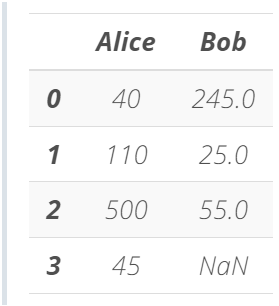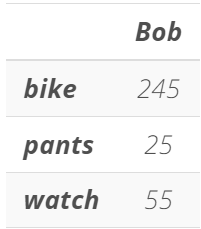创建 Pandas Dataframe
Pandas DataFrames 是具有带标签的行和列的二维数据结构,可以存储很多类型的数据。如果你熟悉 Excel 的话,可以将 Pandas DataFrames 看做类似于电子表格。在接下来的课程中,我们将开始学习如何手动地通过字典创建 Pandas DataFrame,稍后,我们将学习如何将数据文件中的数据加载到 DataFrame 中。
首先,我们将使用 Pandas Series 字典手动创建一个 DataFrame。第一步是创建 Pandas Series 字典。字典创建完毕后,我们可以将该字典传递给 pd.DataFrame() 函数。
我们将创建一个字典,其中包含 Alice 和 Bob 从在线商店中购买的商品。该 Pandas Series 将使用所买商品的价格作为数据,所买商品作为索引标签。我们来看看如何编写代码:
# We import Pandas as pd into Python
import pandas as pd
# We create a dictionary of Pandas Series
items = {'Bob' : pd.Series(data = [245, 25, 55], index = ['bike', 'pants', 'watch']),
'Alice' : pd.Series(data = [40, 110, 500, 45], index = ['book', 'glasses', 'bike', 'pants'])}
# We print the type of items to see that it is a dictionary
print(type(items))
class 'dict'
字典已经创建完毕,我们可以通过将其传递给 pd.DataFrame() 函数,创建 DataFrame。我们将创建一个可以表示多位用户的购物车的 DataFrame,在此例中只有两位用户,即 Alice 和 Bob。
# We create a Pandas DataFrame by passing it a dictionary of Pandas Series
shopping_carts = pd.DataFrame(items)
# We display the DataFrame
shopping_carts

有几个事项需要注意。我们发现 DataFrame 以表格形式显示,和 Excel 电子表格很像,行和列的标签以粗体形式显示。此外注意,DataFrame 的行标签根据构建字典所用的两个 Pandas Series 的索引标签创建而成。DataFrame 的列标签来自字典的键。另一个注意事项是,列按照字母顺序排序,而不是字典中的顺序。稍后我们将发现,当我们从数据文件中向 DataFrame 加载数据时,不会发生这种情况。最后要注意的是,我们发现该 DataFrame 中出现了一些 NaN 值。NaN 是指非数字,Pandas 通过这种方式表示该行和列索引没有值。例如,如果我们查看 Alice 列,我们发现手表索引的值是 NaN。你可以通过查看一开始创建的字典,了解为何是这种情况。可以清晰地看出,Alice 手表标签没有条目。因此,在创建 DataFrame 时,如果特定行索引的特定列没有值,Pandas 将用 NaN 值填充。如果要将此数据馈送到机器学习算法中,我们首先需要删掉这些 NaN 值。在后面的课程中,我们将学习如何处理 NaN 值以及如何清理数据。暂时先将这些值留在我们的 DataFrame 中。
在上述示例中,我们使用具有定义清晰的索引的 Pandas Series 字典创建了 Pandas DataFrame。如果我们不向 Pandas Series 提供索引标签,Pandas 在创建 DataFrame 时将使用数字行索引。我们来看一个示例:
# We create a dictionary of Pandas Series without indexes
data = {'Bob' : pd.Series([245, 25, 55]),
'Alice' : pd.Series([40, 110, 500, 45])}
# We create a DataFrame
df = pd.DataFrame(data)
# We display the DataFrame
df

可以看出,Pandas DataFrame 的行索引从 0 开始,就像 NumPy ndarray 的索引一样。
现在,和 Pandas Series 一样,我们也可以使用属性从 DataFrame 中提取信息。我们输出 shopping_carts DataFrame 中的一些信息
# We print some information about shopping_carts
print('shopping_carts has shape:', shopping_carts.shape)
print('shopping_carts has dimension:', shopping_carts.ndim)
print('shopping_carts has a total of:', shopping_carts.size, 'elements')
print()
print('The data in shopping_carts is:\n', shopping_carts.values)
print()
print('The row index in shopping_carts is:', shopping_carts.index)
print()
print('The column index in shopping_carts is:', shopping_carts.columns)
shopping_carts has shape: (5, 2)
shopping_carts has dimension: 2
shopping_carts has a total of: 10 elements
The data in shopping_carts is:
[[ 500. 245.]
[ 40. nan]
[ 110. nan]
[ 45. 25.]
[ nan 55.]]
The row index in shopping_carts is: Index(['bike', 'book', 'glasses', 'pants', 'watch'], dtype='object')
The column index in shopping_carts is: Index(['Alice', 'Bob'], dtype='object')
在 shopping_carts DataFrame 时,我们将整个字典传递给了 pd.DataFrame() 函数。但是,有时候你可能只对一部分数据感兴趣。在 Pandas 中,我们可以通过关键字 columns 和 index 选择要将哪些数据放入 DataFrame 中。我们来看一些示例:
# We Create a DataFrame that only has Bob's data
bob_shopping_cart = pd.DataFrame(items, columns=['Bob'])
# We display bob_shopping_cart
bob_shopping_cart

# We Create a DataFrame that only has selected items for both Alice and Bob
sel_shopping_cart = pd.DataFrame(items, index = ['pants', 'book'])
# We display sel_shopping_cart
sel_shopping_cart

你还可以使用列表(数组)字典手动地创建 DataFrame。流程和之前一样,首先创建一个字典,然后将该字典传递给 pd.DataFrame() 函数。但是在这种情况下,字典中的所有列表(数组)长度必须一样。我们来看一个示例:
# We create a dictionary of lists (arrays)
data = {'Integers' : [1,2,3],
'Floats' : [4.5, 8.2, 9.6]}
# We create a DataFrame
df = pd.DataFrame(data)
# We display the DataFrame
df

注意,因为我们创建的 data 字典没有标签索引,因此 Pandas 在创建 DataFrame 时自动使用数字行索引。但是,我们可以通过在 pd.DataFrame() 函数中使用关键字 index,为行索引添加标签。我们来看一个示例:
# We create a dictionary of lists (arrays)
data = {'Integers' : [1,2,3],
'Floats' : [4.5, 8.2, 9.6]}
# We create a DataFrame and provide the row index
df = pd.DataFrame(data, index = ['label 1', 'label 2', 'label 3'])
# We display the DataFrame
df

手动创建 Pandas DataFrame 的最后一种方式是使用 Python 字典列表。流程和之前一样,我们先创建字典,然后将该字典传递给 pd.DataFrame() 函数。
# We create a list of Python dictionaries
items2 = [{'bikes': 20, 'pants': 30, 'watches': 35},
{'watches': 10, 'glasses': 50, 'bikes': 15, 'pants':5}]
# We create a DataFrame
store_items = pd.DataFrame(items2)
# We display the DataFrame
store_items

同样注意,因为我们创建的 items2 字典没有标签索引,因此 Pandas 在创建 DataFrame 时自动使用数字行索引。和之前一样,我们可以通过在 pd.DataFrame() 函数中使用关键字 index,为行索引添加标签。假设我们将使用该 DataFrame 存储某个商店的商品库存数量。我们将行索引的标签设为 store 1 和 store 2。
# We create a list of Python dictionaries
items2 = [{'bikes': 20, 'pants': 30, 'watches': 35},
{'watches': 10, 'glasses': 50, 'bikes': 15, 'pants':5}]
# We create a DataFrame and provide the row index
store_items = pd.DataFrame(items2, index = ['store 1', 'store 2'])
# We display the DataFrame
store_items























 984
984











 被折叠的 条评论
为什么被折叠?
被折叠的 条评论
为什么被折叠?








